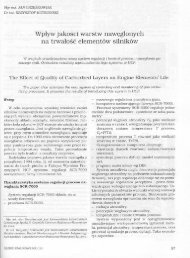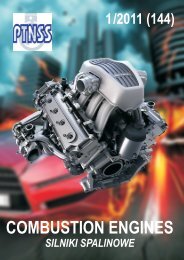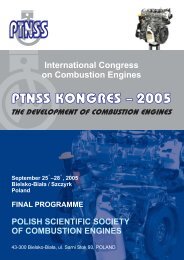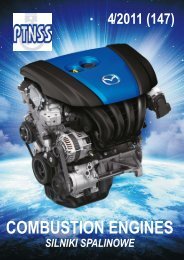You also want an ePaper? Increase the reach of your titles
YUMPU automatically turns print PDFs into web optimized ePapers that Google loves.
Badania możliwości poprawy równomierności odsysania pyłu z osadnika multicyklonu filtru powietrza...<br />
through a pipe on the front wall of the multicyclone (Fig.<br />
1). The Cyclones are located at different distances from the<br />
extraction pipe. The last cyclone in the row is located at a<br />
distance that is 12 times greater than the cyclone closest to<br />
the extraction pipe. This significantly influences the extraction<br />
from the individual cyclones (Fig. 2).<br />
From the characteristics presented in Fig. 2 it results<br />
that the greatest values of the streams QSC extracted from<br />
the cyclones of the upper column of the multicyclone are in<br />
the range of Q SC<br />
= 1.83 ÷ 6.4 m 3 /h, irrespective of the value<br />
of the main extraction stream Q SF<br />
, for the cyclones that are<br />
the closest to the extraction pipe of the dust collector of the<br />
multicyclone. As the distance of the cyclone location grows a<br />
systematic drop in the extraction stream Q SC<br />
takes place and<br />
for cyclone XIII the Q SC<br />
streams assume values in the range<br />
Q SC<br />
= 1.42 ÷ 4.32 m 3 /h i.e. more than 30% lower. This clearly<br />
impacts the efficiency of the cyclone dedusting.<br />
In order to better monitor the test results the values of<br />
Q SC<br />
for the subsequent cyclone of the column and for the<br />
same main extraction stream Q SS<br />
have been connected with<br />
straight lines. Ensuring identical values of the streams extracted<br />
from all multicyclones requires a modification of the<br />
whole system, particularly the dust collector.<br />
2. The concept of dedusting from a multicyclone<br />
In order to ensure an even extraction from the individual<br />
cyclones of the multicyclone the most appropriate<br />
seems the modification of the structure of the multicyclone<br />
dust collector through partitioning of the collector space<br />
into sections and each section into independent isolated<br />
extraction channels that should be assigned to groups of<br />
individual cyclones [5, 7, 8]. Schematics of such partitioning<br />
of the dust collector into sections and the sections<br />
into extraction channels (for the BWP-1 vehicle) has been<br />
shown in Fig. 3.<br />
The dust collector chamber of the multicyclone has<br />
been partitioned into three identical and independent sections<br />
S of width a. Each has been assigned a column of<br />
13 cyclones (I, II, III, ..., XII, XIII). The section can have<br />
different numbers of extraction channels and each can have<br />
a different number of cyclones assigned. The chambers of<br />
the dust collectors of the sections (Fig. 3) have been divided<br />
with horizontal (parallel against one another and against<br />
the bottom) partitions into four separate extraction channels<br />
of different heights h 1<br />
, h 2<br />
, h 3<br />
, h 4<br />
. The basic problem when<br />
dividing the chamber of the dust collector of each section<br />
into the extraction channels is to set the horizontal partitions<br />
on appropriate heights h 1<br />
, h 2<br />
, ..., h i<br />
. To this end the<br />
authors developed a calculation algorithm that allows an<br />
initial selection of the heights at the outlet h 1<br />
, h 2<br />
, ...., h i<br />
, of<br />
the subsequent extraction channels of the dust collector so<br />
that identical flow resistance of the air through the channels<br />
is maintained [5, 7, 8]. The final selection of the number<br />
and height h 1<br />
, h 2<br />
, ...., h i<br />
had to be made during experimental<br />
research on a separate section of the multicyclone. Such<br />
research has been carried out for a section of a multicyclone<br />
fitted in the BWP-1 vehicle.<br />
się najbliżej otworu wylotowego króćca odsysania osadnika<br />
pyłu multicyklonu i zawierają się w zakresie Q SC<br />
= 1,83 ÷ 6,4<br />
m 3 /h. Wraz z oddalaniem się położenia cyklonów od tego<br />
miejsca następuje systematyczny spadek strumieni Q SC<br />
i dla<br />
cyklonu nr XIII strumienie Q SC<br />
przyjmują wartości w zakresie<br />
Q SC<br />
= 1,42 ÷ 4,32 m 3 /h, a więc o ponad 30% mniejsze. Ma to<br />
niewątpliwie wpływ na skuteczność odpylania cyklonów.<br />
W celu lepszego śledzenia wyników badań wartości Q SC<br />
dla kolejnych cyklonów kolumny i dla tego samego głównego<br />
strumienia odsysania Q SS<br />
połączono liniami prostymi.<br />
Zapewnienie jednakowych wartości strumieni odsysających<br />
ze wszystkich minicyklonów wymaga wykonania modyfikacji<br />
układu odsysania zanieczyszczeń, a w szczególności<br />
osadnika pyłu.<br />
2. Koncepcja układu odsysania pyłu<br />
z multicyklonu<br />
Dla zapewnienia równomiernego odsysania strumieni<br />
z pojedynczych cyklonów multicyklonu najbardziej odpowiedni<br />
wydaje się sposób polegający na zmianie struktury<br />
osadnika pyłu multicyklonu, przez podział przestrzeni osadnika<br />
przegrodami na segmenty, a segmentu na niezależne,<br />
odizolowane od siebie kanały odsysania, którym należy<br />
przyporządkować określone grupy pojedynczych cyklonów<br />
[5, 7, 8]. Schemat ideowy podziału osadnika multicyklonu<br />
pojazdu specjalnego BWP-1 na segmenty, a segmentu na<br />
kanały odsysania przedstawiono na rys. 3.<br />
Komorę osadnika pyłu multicyklonu podzielono na<br />
szerokości ścianami wewnętrznymi (przegrodami) na trzy<br />
jednakowe i niezależne części (segmenty S) o szerokości<br />
a. Każdemu przyporządkowano kolumnę 13 (I, II, III, ...<br />
XII, XIII) cyklonów, co stanowi segment. Segment może<br />
zawierać różne liczby kanałów odsysania, a do każdego może<br />
być przypisana inna liczba cyklonów. Komory osadników<br />
segmentów (rys. 3) podzielono poziomymi (równoległymi<br />
do siebie i do dna osadnika) przegrodami na cztery odrębne<br />
kanały odsysania o różnych wysokościach h 1<br />
, h 2<br />
, h 3<br />
, h 4<br />
.<br />
Podstawowym problemem przy podziale komory osadnika<br />
segmentu na kanały odsysania jest ustawienie poziomych<br />
Fig. 3. Schematics of the dust collector partitioning in the multicyclone<br />
of the air cleaner [7]<br />
Rys. 3. Schemat ideowy podziału osadnika pyłu multicyklonu filtru<br />
powietrza na segmenty [7]<br />
36 <strong>COMBUSTION</strong> <strong>ENGINES</strong>, No. 4/2012 (151)












